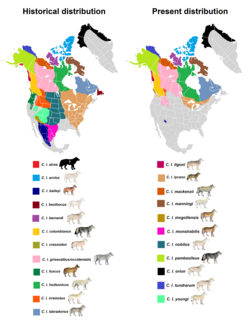| Hudson Bay wolf | |
|---|---|
 | |
| C. l. hudsonicus, Olomouc Zoo, Czech Republic | |
| Scientific classification | |
| Domain: | Eukaryota |
| Kingdom: | Animalia |
| Phylum: | Chordata |
| Class: | Mammalia |
| Order: | Carnivora |
| Family: | Canidae |
| Genus: | Canis |
| Species: | |
| Subspecies: | C. l. hudsonicus |
| Trinomial name | |
| Canis lupus hudsonicus Goldman, 1941 | |
 | |
| Historical and present range of gray wolf subspecies in North America | |
| Synonyms | |
Canis albus hudsonicus | |
The Hudson Bay wolf (Canis lupus hudsonicus) is a subspecies of gray wolf native to the northern Kivalliq Region, including the northwestern coast of Hudson Bay in Canada. It was first classed as a distinct subspecies in 1941 by Edward Goldman, who described it as being a white colored, medium-sized subspecies similar to C. l. arctos , but with a flatter skull. [2] This wolf is recognized as a subspecies of Canis lupus in the taxonomic authority Mammal Species of the World (2005). [3]

